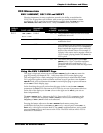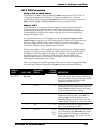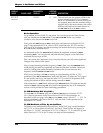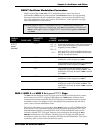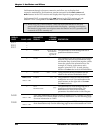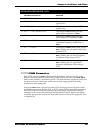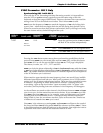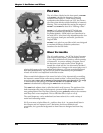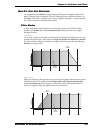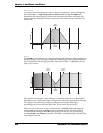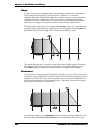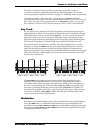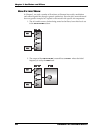
Chapter 5: Oscillators and Filters
ANDROMEDA A6 REFERENCE MANUAL 115
SYNC Parameter: OSC 2 Only
Synchronizing OSC 1 with OSC 2
Even with the VCOs’ fine tuning and ultra-fine tuning controls, it is impossible to
tune the VCOs to perfect unison, especially across the entire range of the A6’s
keyboard or the wider range of MIDI Notes. There may be times when you need the
tuning of two VCOs to be locked to each other. This is where
SYNC is used.
SYNC forces the frequency of OSC 2 to match the frequency of OSC 1 by locking their
waves’ phase – when the waves begin their rise and fall during their periodic cycles.
When two sound waves have their phases synchronized, their cycles begin at exactly
the same instant and stay locked throughout the cycle.
DISPLAY
PAGE PANEL LABEL
PARAMETER
DISPLAY
OPTIONS
or RANGE
DESCRIPTION
TUNE
SYNC
Button +
Two LEDs
SYNC OFF
Turns the synchronization of OSC 2 to OSC 1
off. Both VCOs oscillate independently.
HARD
Turns HARD SYNC on. See description below.
SOFT
Turns SOFT SYNC on. See description below.
Pressing the SYNC button rotates among three synchronizing possibilities: the first
press activates
HARD sync, the second press activates SOFT sync, and the third press
turns
SYNC off. You can also use soft knob 7 when OSC 2’s TUNE page is displayed.
The choices, in order, are
- OFF -, SOFT and HARD.
HARD sync locks the phase relationship of OSC 2’s fundamental wave with that of OSC
1
. SOFT sync locks the phase relationships of OSC 2’s harmonics with the harmonics of
OSC 1. The audible difference between these two methods depends on the frequencies
of the VCOs before sync is activated.
When tuned to approximately the same frequency, there’s not much (if any) audible
difference between hard and soft sync. What you’ll experience is two VCOs tuned to
perfect (well, for all intents and purposes) unison. There may be a noticeable increase
in loudness – depending on which waveforms are selected – resulting from two
waves being “right on top of each other” (more accurately called “in phase” with
each other), and any beating from two oscillators in close frequency will disappear.
As the oscillators are tuned to wider intervals, the difference between
HARD and SOFT
sync (or no sync, for that matter) becomes more obvious. If you tune OSC 2 up a fifth
from
OSC 1 then turn HARD sync on, for example, a new set of harmonics are created
resulting from two fundamental waves – with significantly different frequencies –
being locked in phase: the waveforms start their cycles at the same time. Another set
of harmonics is created when
SOFT sync is used.
Since
OSC 1 is the reference, try tuning OSC 1 up from OSC 2 and listen to the result of
the slaved oscillator (
OSC 2) being tuned below the reference oscillator (OSC 1). Listen
to the difference between hard and soft sync in this situation. You might also want to
experiment with octave intervals and dissonant intervals as well.



